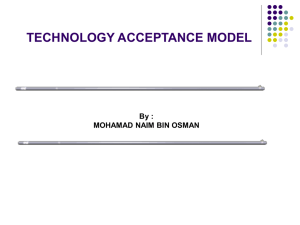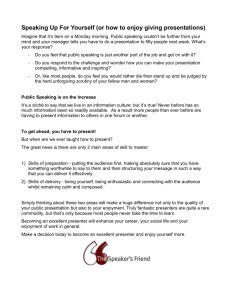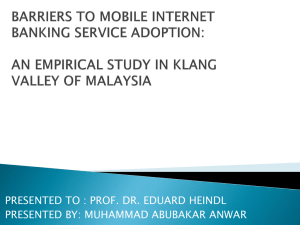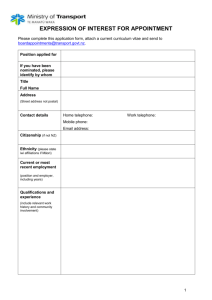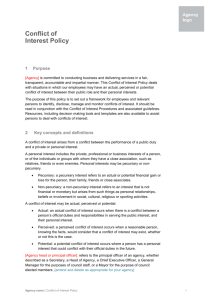Factors Influencing the Usage of Websites: The Case of a Generic
advertisement
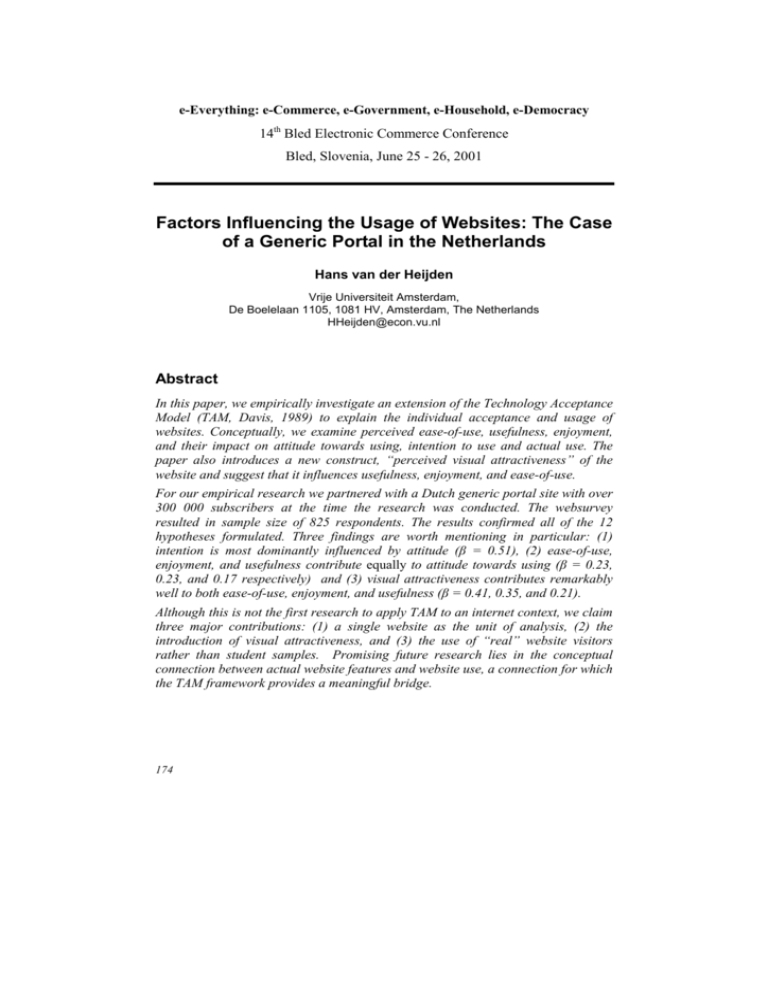
e-Everything: e-Commerce, e-Government, e-Household, e-Democracy 14th Bled Electronic Commerce Conference Bled, Slovenia, June 25 - 26, 2001 Factors Influencing the Usage of Websites: The Case of a Generic Portal in the Netherlands Hans van der Heijden Vrije Universiteit Amsterdam, De Boelelaan 1105, 1081 HV, Amsterdam, The Netherlands HHeijden@econ.vu.nl Abstract In this paper, we empirically investigate an extension of the Technology Acceptance Model (TAM, Davis, 1989) to explain the individual acceptance and usage of websites. Conceptually, we examine perceived ease-of-use, usefulness, enjoyment, and their impact on attitude towards using, intention to use and actual use. The paper also introduces a new construct, “perceived visual attractiveness” of the website and suggest that it influences usefulness, enjoyment, and ease-of-use. For our empirical research we partnered with a Dutch generic portal site with over 300 000 subscribers at the time the research was conducted. The websurvey resulted in sample size of 825 respondents. The results confirmed all of the 12 hypotheses formulated. Three findings are worth mentioning in particular: (1) intention is most dominantly influenced by attitude (β = 0.51), (2) ease-of-use, enjoyment, and usefulness contribute equally to attitude towards using (β = 0.23, 0.23, and 0.17 respectively) and (3) visual attractiveness contributes remarkably well to both ease-of-use, enjoyment, and usefulness (β = 0.41, 0.35, and 0.21). Although this is not the first research to apply TAM to an internet context, we claim three major contributions: (1) a single website as the unit of analysis, (2) the introduction of visual attractiveness, and (3) the use of “real” website visitors rather than student samples. Promising future research lies in the conceptual connection between actual website features and website use, a connection for which the TAM framework provides a meaningful bridge. 174 Factors Influencing the Usage of Websites: The Case of a Generic Portal in the Netherlands 1. Introduction Website traffic is arguably one of the most important performance indicators for ecommerce practitioners. Not only does traffic reflect popularity of the website, it is also a prerequisite for generating online sales, and it provides a basis for acquiring revenue from web-based advertising agencies (Hanson, 2000). For all these reasons, many companies increasingly adopt strategies to generate more website traffic (Quelch and Klein, 1996). Also, website updates are increasingly being evaluated in terms of the traffic changes that they induce (Heijden, 2000). The drivers of website traffic are certainly not well known (Kraut, et al., 1999). Indeed, obtaining and retaining visitors on a corporate website continues to be one of the most elusive problems facing the average Internet firm. To increase our understanding in this area, this paper aims to provide more insight into the question why people do or do not use a particular site. We do so by developing a version of the Technology Acceptance Model (TAM), and by empirically validating this model in the context of a Dutch portal site. TAM is a parsimonious, theoretically and empirically justified model to explain the acceptance of information systems. While our research is not the first that applies TAM to an Internet context (for recent examples, see (Atkinson and Kydd, 1997; Moon and Kim, 2001; Teo, et al., 1999)), we aim to make three contributions to the existing body of literature. First, we focus on the application of the TAM framework for a specific website, not for the Internet in general as our predecessors have done. A TAM test of single website usage is more powerful than a TAM test of generic Internet usage, because the results would have more obvious implications for e-commerce managers. Second, we introduce a new construct, Perceived Attractiveness, into the model. Third, we use “real website users” for the empirical validation of the TAM framework. Our predecessors have almost exclusively used student samples, who are potentially less involved. This paper is outlined as follows. First, the original version of the Technology Acceptance Model will be discussed. Following this is a brief review of the empirical and theoretical progress of TAM over the past years. The next section starts with an outline of the revised framework and provides 12 hypotheses that can be derived from this framework. We then describe the research method which was adopted to validate the model. Descriptive results and analysis follow research design. We give an interpretation of the findings and discuss the contributions and limitations of our work. Finally, we present the conclusions and discuss the implications for researchers and practitioners. 2. Theoretical Background: The Technology Acceptance Model Our model to explain why people revisit websites is based on the advancements of TAM in “traditional” information systems, and it is complemented by recent theoretical and empirical findings on Internet use. Figure 1 displays the model. 175 Hans van der Heijden Perceived Usefulness H3 (+) H9 (+) H8 (+) Perceived H12 (+) Attractiveness Perceived Ease of Use H10 (+) H11 (+) Perceived Enjoyment H5 (+) H6 (+) Attitude towards Use H2 (+) Intention to Use H1 (+) Actual Usage H7 (+) H4 (+) Figure 1: Revised TAM conceptual framework (adapted from (Davis, 1989; Davis, et al., 1989; Davis, et al., 1992)) The original version of the Technology Acceptance Model was put forward by Davis et al. (Davis, 1989; Davis, et al., 1989). TAM adopts the well-established causal chain of beliefs -> attitude -> intention -> behaviour that has been put forward by social psychologists Fishbein and Ajzen (Ajzen, 1991; Fishbein and Ajzen, 1975), and which has become known as the Theory of Reasoned Action (TRA). Based on certain beliefs, a person forms an attitude about a certain object, on the basis of which he or she forms an intention to behave with respect to that object. The intention to behave is the sole determinant of actual behaviour. In line with reasoning applied in TRA and TAM, we hypothesise that there exists a direct and positive effect between attitude towards usage, website usage intention and actual website usage. Research on TRA and TAM has consistently found strong empirical support for these relationship: attitudes and intentions can accurately explain and predict actual behaviour. H1: Intention to use a website positively influences actual website usage H2: Attitude towards usage positively influences intention to use a website Davis adapted the Theory of Reasoned Action by developing two key beliefs that specifically account for information system usage. The first of these believes is perceived usefulness, defined as “the degree to which a person believes that using a particular system would enhance his or her job performance.” (Davis, 1989), p.320. The second is perceived ease-of-use, defined as “the degree to which a person believes that using a particular system would be free of effort” (Davis, 1989), p.320. Moreover, TAM theorises that all other external variables, such as system-specific characteristics, are fully mediated by these two key believes. Davis et al. tested the original version of TAM on the voluntary usage of a word processing program by first year U.S. MBA students (Davis, 1989). They found support for a more parsimonious TAM model through the omission of the attitude construct. Adams et al. (Adams, et al., 1992) replicated a simplified version of TAM without both the attitude and intention constructs. They tested the model using two studies, one concerning the use of E-mail and voicemail systems, the other concerning three types of office-systems. They found inconsistent results for the relationship between ease-of-use and usage. Studying the acceptance of a voice176 Factors Influencing the Usage of Websites: The Case of a Generic Portal in the Netherlands mail system by 75 U.S. subjects and a customer dial up system by 104 subjects, Subramanian (Subramanian, 1994) also found no support for any of the ease-of-use relationships. Taylor & Todd (Taylor and Todd, 1995) contrast the Technology Acceptance Model with two models derived from the Theory of Planned Behaviour (TPB). TPB is an extension of TRA developed by Ajzen (Ajzen, 1991) and adds perceived behavioural control as determinant for intention and actual usage. The object of study involved the voluntary usage of a computing resource centre by undergraduate and graduate U.S. business students. Taylor & Todd found superior goodness-of-fit measures for the TPB models, but the addition of subjective norms and perceived behavioural control did not substantially increase the amount of variance of usage behaviour already explained by TAM (36% compared to 34%). In sum we hypothesise that usefulness influences website usage indirectly through attitude and directly through intent. H3: Perceived usefulness positively influences the intention to use a website H5: Perceived usefulness positively influences the attitude towards using a website To explicitly model the role of intrinsic motivation in TAM, Davis et al. (Davis, et al., 1992) introduce the concept of perceived enjoyment. Perceived enjoyment is defined as “the extent to which the activity of using the computer is perceived to be enjoyable in its own right, apart from any performance consequences that may be anticipated” (Davis, et al., 1992), p. 1113. Perceived enjoyment is theorised to influence usage intention directly. To test the influence of enjoyment two studies were conducted, one involving the adoption of a word-processing program by 200 U.S. MBA students and another concerned with the adoption of a graphics program by 40 U.S. MBA students. The results confirmed the strong relationship between usefulness and user intention (β = .68 for Study 1, β = .79 for Study 2) and a weaker relationship between enjoyment and intention (β = .16 for Study 1, β = .15 for Study 2). The influence of perceived ease-of-use was fully mediated through perceived usefulness and enjoyment. A few studies have been done in which the perceived enjoyment concept is further developed. Igbaria et al. (Igbaria, et al., 1995) studied the effect of perceived enjoyment and usefulness on usage in a field study of Finnish computer users. They found strong relationships between perceived usefulness and usage, but weak, insignificant links between enjoyment and usage. Similarly, Igbaria et al. (Igbaria, et al., 1996) studied the effect of perceived fun/enjoyment using data from 471 respondents from a diverse range of U.S. based organisations. In this study, support was found for a positive relationship between perceived fun/enjoyment and system usage. Perceived complexity (the opposite of perceived ease-of-use) was negatively correlated with perceived enjoyment. Previous research on the use of the World Wide Web (WWW) has found empirical support for enjoyment as a driver of Internet usage. For example, Atkinson & Kydd (Atkinson and Kydd, 1997) used a sample of 78 undergraduate business students and 84 graduate MBA students to test a model in which WWW usage was related to 177 Hans van der Heijden usefulness and enjoyment. They found that perceived enjoyment significantly influenced WWW use for entertainment purposes (β = 0.308) whereas usefulness was not significant. Similarly, perceived usefulness significantly influenced WWW use for course-related purposes (β = 0.502) whereas enjoyment was not significant. Teo et al. (Teo, et al., 1999) employed a web-based survey to investigate the impact of ease-of-use, usefulness, and enjoyment on Internet use. 1370 usable responses were obtained. Their findings indicate that respondents use the Internet both through perceived usefulness and perceived enjoyment. In comparison with Atkinson & Kydd, Usefulness had a weaker effect on Frequency-of-Use (β = 0.19). Similarly, the effect of Enjoyment on Frequency-of-Use, while significant, was also weaker (β = 0.09). Moon & Kim (Moon and Kim, 2001) used a sample of 152 Korean graduate students to test the influence of perceived usefulness and playfulness (enjoyment) on WWW use. They found considerable support for the mediation of attitude and intention. H4: Perceived enjoyment positively influences the intention to use a website H7: Perceived enjoyment positively influences the attitude towards using a website Previous TAM research demonstrates strong empirical support for a positive relationship between perceived ease-of-use and perceived usefulness. In a website environment we expect this relationship to hold also: the easier a website is to learn, use, or navigate, the more useful it would be perceived to be relative to its competitors. Similarly, perceived ease-of-use can be associated with perceived relative enjoyment: the easier the system is to use, the more enjoyable it is. Empirical research has also found support for this relationship in traditional settings (Igbaria, et al., 1996). Perceived relative enjoyment is related to the psychological concept of “flow” (Csikszentmihalyi, 1977), which is described as an “intrinsically enjoyable experience”. Flow, which has also been studied in an Internet context (Hoffman and Novak, 1996; Novak, et al., 2000), arises under a number of conditions. One of these is the instant feedback following a person’s stimuli. It is conceivable that a website that is easier to use provides better feedback to a visitor’s stimuli, and consequently, leads to increased enjoyment and flow. In sum: H8: Perceived ease-of-use positively influences perceived usefulness H10: Perceived ease-of-use positively influences perceived enjoyment A final hypotheses on ease-of-use relates ease-of-use directly to attitude towards use. This hypothesis is controversial because as shown above empirical evidence for this relationship has been mixed. H6: Perceived ease-of-use positively influences attitude towards using a website „Perceived visual attractiveness“ is a new construct which we define in this paper as the degree to which a person believes that the website is aesthetically pleasing to the eye. The attractiveness of the website refers to the visual elements of the site, most notably the colours used and the lay-out of the website. Colours and lay-out 178 Factors Influencing the Usage of Websites: The Case of a Generic Portal in the Netherlands are direct system features, which according to TAM can only impact website usage through usefulness, enjoyment, and ease-of-use. In sum, we hypothesise: H9: Perceived visual attractiveness positively influences perceived usefulness H11: Perceived visual attractiveness positively influences perceived ease-of-use H12: Perceived visual attractiveness positively influences perceived enjoyment 3. Research Design We sought to validate our theoretical model and the hypotheses discussed above through a survey of users of one particular website. This had the advantage that all respondents provided their opinions using the same reference point, and was similar to testing approaches adopted by other TAM scholars who used one specific information system. We chose a website that seemed both useful and enjoyable. Portal sites usually combine both features, so we partnered with a Dutch generic portal that had over 300 000 subscribers at the time of research. In developing the survey instrument, we chose both single item and multiple item constructs. For the multiple item constructs we adopted measures that were similar to those used in the literature. Single item questions had to be selected for some constructs (attitude, intention and usage) because the survey was deemed to be too lengthy when every construct had multiple items. This would have contributed unfavourably to the overall response rate. The complete questionnaire is included in the appendix to this paper. The survey was programmed according to our specifications by the technical department of the portal company. It was then distributed (through a pop-up screen) to every 20th subscriber that entered the portal. Through this approach, we aimed to ensure an aselect sampling of the total number of active subscribers. In less than three days we had an overwhelming response of 887 people, after which we decided to close down the survey for reasons of tractability. When the sample was cleaned for meaningless survey responses, we had a sample of 825 respondents at our disposal. 4. Discussion of Results Table 1 presents a descriptive profile of the sample. The demographic figures show that the majority of the sample is male, highly educated, and between 30 and 50. The portal company confirmed that these findings were in line with findings from their own marketing research. Because the average age of the general internet population is usually perceived to be somewhat younger (Hanson, 2000), the sample is not likely to be entirely representative of the present population. However, because the adoption of the internet is growing at a very fast pace, they are likely to be more representative of the future population. 179 Hans van der Heijden Measure Items Frequency Percent Gender Male Female Missing 640 159 26 77.6 19.3 3.2 Age <21 22-29 30-39 40-49 50-59 >60 Missing 110 103 198 212 136 42 24 13.3 12.5 24.0 25.7 16.5 5.1 2.9 Education Lower education Highschool education College education Missing 42 364 396 23 5.1 44.1 48.0 2.8 Table 1: Descriptive statistics of respondents' characteristics (n = 825) We examined the reliability of each of the constructs using Cronbach Alpha (Nunally, 1967). These are depicted in Table 2. Construct (Number of Items) Perceived Ease of Use (3) Alpha Coefficient 0.81 Perceived Enjoyment (3) 0.82 Perceived Usefulness (3) 0.83 Perceived Attractiveness (3) 0.83 Table 2: Alpha coefficients for constructs with multiple items in the model All independent variables demonstrate acceptable values (>0.80), which indicates that these are reliable measures for their respective constructs. To test the hypotheses we conducted multiple regression analyses on the variables Actual Usage, Intention to use, Attitude, Intention, Usefulness, Enjoyment, and Ease of Use. The results are described in the Table below. As can be seen from this table, the data fully supported the model and all hypotheses cannot be rejected on the basis of this empirical data. A number of findings are worth mentioning in particular. In the first place, intention is most dominantly influenced by attitude (β = 0.51) and less so by usefulness (β =0.18) and enjoyment (β=0.11). This implies that attitude is indeed a very powerful mediator between the two beliefs and the intention to use. Previous researchers (Adams, et al., 1992; Davis, 1989) have suggested that the inclusion of attitude is not meaningful; our research suggests otherwise. We argue that attitude should continue to be used in subsequent TAM research. 180 Factors Influencing the Usage of Websites: The Case of a Generic Portal in the Netherlands Second, the impacts of enjoyment and ease-of-use on attitude are almost as high as the impact of usefulness. This is surprising indeed given the completely different weights that these constructs have enjoyed traditionally in previous research. From the literature survey in the beginning of this paper it can be derived that enjoyment is typically at β’s around 0.10. The influence of ease-of-use is sometimes even insignificant. As an explanation for the result, we suggest that the „function of the system under study“ matters. Portals have both entertainment and enjoyment functions, and therefore both feelings matter. Traditional information systems typically serve a „useful“ function only (in a job-context) and therefore only the „usefulness“ belief matters. The direct impact of ease-of-use can probably be explained from the strong impact of this construct on both usefulness and enjoyment. We suggest therefore that future TAM research should specifically take into account the function of the website or information system under study. Model Actual usage (AU) AU = BI + errors Behavioural intention to use (BI) BI = A + PU + PE + errors A PU PE Attitude towards using (A) A = PU + PE + PEU + errors PU PEU PE Perceived usefulness (PU) PU = PEU + ATTR + Errors PEU Visual Attractiveness Perceived enjoyment (PE) PE = PEU + ATTR + Errors PEU Visual Attractiveness Perceived ease of use (PEU) PEU = Visual Attractiveness + Errors R2 0.316*** β Hypothesis result 0.562*** H1: Supported 0.507*** 0.177*** 0.114** H2: Supported H3: Supported H4: Supported 0.170*** 0.232*** 0.228*** H5: Supported H6: Supported H7: Supported 0.491*** 0.208*** H8: Supported H9: Supported 0.316*** 0.348*** H10: Supported H11: Supported 0.416*** H12: Supported 0.402*** 0.274*** 0.369*** 0.313*** 0.173*** Table 3: Results of hypotheses tests ** = p<0.005, *** = p<0.001 A third finding revolves around the visual attractiveness construct. As can be seen from the table, attractiveness contributes to feelings of usefulness with a β of 0.21, to feelings of enjoyment with a β of 0.35 and to feelings of ease-of-use with a β of 0.42. These coefficients are somewhat extraordinary for a new construct and suggest that visual attractiveness is a much more powerful concept than is hitherto assumed. 181 Hans van der Heijden Perceived Usefulness PEU Visual Attractiveness Perceived Enjoyment PEU Visual Attractiveness Baseline TAM model R2 β 0.333*** 0.577*** 0.212*** 0.461*** - Extended TAM model R2 β 0.369*** 0.491*** 0.208*** 0.313*** 0.316*** 0.348*** Table 4: The contribution of the attractiveness construct Does the visual attractiveness construct contribute much to the original model? In order to examine this question we performed multiple regression tests with and without the attractiveness construct. Table 4 compares the results. The results confirm that the inclusion of the visual attractiveness construct does contribute to the R2 of enjoyment, and only slightly so for usefulness. In other words, attractiveness helps to explain enjoyment better than it helps to explain usefulness. Based on these results, we can conclude that the extended TAM model is better off with inclusion of the visual attractiveness construct. TAM researchers are strongly advised to look further into this construct and explore it both conceptually as well as empirically. 5. Contributions and Future Research The objective of this paper has been to develop a revised version of the Technology Acceptance Model to understand a person’s usage behaviour on a single website. TAM explains information system usage by recognising both extrinsic and intrinsic motivations. This has originally been done through the operationalisation of two key individual beliefs: perceived usefulness and perceived enjoyment. Furthermore, TAM theorises that the effects of perceived ease-of-use and other external variables on system use are fully mediated by these two key beliefs. This paper has contributed to the original TAM model by incorporating the conceptual findings of previous TAM research, by successfully introducing the concept of visual attractiveness, and by empirically validating the model against „real“ website users. Perhaps the most promising area of further research is in the extension of the TAM model towards the incorporation of actual website characteristics. A substantial body of research is now accumulating that categorises and classifies websites along various dimensions, e.g. (Barnes and Vidgen, 2000; Elliot, et al., 2000; Gillenson, et al., 2000; Huizingh, 2000). These classification and assessment frameworks provide useful descriptive information on the state of one website compared to other websites. Moreover, through the exposition of the differences in “scores”, these frameworks encourage designers to examine potential white spots in comparison with competing websites. The TAM framework may be complementary to this research in that it provides a means to link these dimensions towards actual revisits. Our work is subject to a number of limitations. In the first place, we have investigated only one website, one that had both useful features as well as enjoyable 182 Factors Influencing the Usage of Websites: The Case of a Generic Portal in the Netherlands features. As discussed, this had repercussions on the relative impact of feelings of usefulness and enjoyment on usage. Second, there is obviously a survival bias in the sample, because those that were unsatisfied with the website would have ceased to use it, and therefore could not have come across the websurvey. Finally, in terms of operationalisation we used single-item measures for the constructs of attitude, intention and usage. This increases the possibilities of measurement error and therefore, regressions on these variables should be interpreted with care. Understanding why individuals return or fail to return to a website may continue to be an elusive topic for a while. This research provides a first step by outlining a meaningful bridge between website features (and other external variables) and the actual usage of a website. Researchers are therefore encouraged to pursue the relationships between different features and different usage rates through this bridge. Appendix This appendix contains the statements used in the survey. Respondents were asked to what degree they agree or disagree with these statements on a 5-point Likert scale. Attitude, intention, usage 1. I have a positive attitude towards this portal | Wholly disagree / Wholly agree 2. I intend to visit the portal frequently | Wholly disagree / Wholly agree 3. How often do you visit the portal? | Hardly or Never / Very often 4. How intensive do you browse the site? | Very shallow / Very intensive1 Perceived Ease-of-Use 5. It is easy to navigate around the site | Wholly disagree / Wholly agree 6. I can quickly find the information that I need | Wholly disagree / Wholly agree 7. I think it is a user-friendly site | Wholly disagree / Wholly agree Perceived Usefulness 8. I find this portal overall a useful site | Wholly disagree / Wholly agree 9. The information on the site is interesting to me | Wholly disagree / Wholly agree 10. I find this a site that adds value | Wholly disagree / Wholly agree Perceived Enjoyment 11. I find this portal overall an entertaining site | Wholly disagree / Wholly agree 12. I browse the site for pleasure | Wholly disagree / Wholly agree 1 Item dropped in the analysis. 183 Hans van der Heijden 13. Browsing this portal is an agreeable way of passing time | Wholly disagree / Wholly agree Perceived Attractiveness 14. Overall, I find that the site looks attractive | Wholly disagree / Wholly agree 15. The lay-out of the site is attractive | Wholly disagree / Wholly agree 16. The colours that are used on the site are attractive | Wholly disagree / Wholly agree Some data about yourself: Your age: <21 / 22-29 / 30-39 / 40-49 / 50-59 / 60> Your highest level of education: <3 levels of education according to the Dutch education system> Are you: male / female? References Adams, D.A., Nelson, R.R. and Todd, P.A. "Perceived usefulness, ease of use, and usage of information technology: a replication," MIS Quarterly (1992:June), 1992, pp. 227-247. Ajzen, I. "The theory of planned behaviour," Organisational behaviour and human decision processes (50), 1991, pp. 179-211. Atkinson, M.A. and Kydd, C. "Individual characteristics associated with World Wide Web use: an empirical study of playfulness and motivation," Data base for advances in information systems (28:2), 1997, pp. 53-62. Barnes, S.J. and Vidgen, R. "Information and interaction quality: evaluating internet bookshop websites with WebQual," Proceedings of the 13th Bled Electronic Commerce Conference, Bled, Slovenia, 2000, pp. 426-444. Csikszentmihalyi, M. Beyond boredom and anxiety, Jossey-Bass, San Francisco, 1977. Davis, F.D. "Perceived usefulness, perceived ease of use, and user acceptance of information technology," MIS Quarterly (1989:September), 1989, pp. 319340. Davis, F.D., Bagozzi, R.P. and Warshaw, P.R. "User acceptance of computer technology: a comparison of two theoretical models," Management Science (35:8), 1989, pp. 983-1003. Davis, F.D., Bagozzi, R.P. and Warshaw, P.R. "Extrinsic and intrinsic motivation to use computers in the workplace," Journal of Applied Social Psychology (22), 1992, pp. 1111-1132. Elliot, S.R., Morup-Petersen, A.S. and Bjorn-Andersen, N. "Towards a framework for evaluation of commercial websites," Proceedings of the 13th Bled Electronic Commerce Conference, Bled, Slovenia, 2000, pp. 69-86. 184 Factors Influencing the Usage of Websites: The Case of a Generic Portal in the Netherlands Fishbein, M. and Ajzen, I. Belief, attitude, intention and behaviour: an introduction to theory and research, Addison-Wesley, Reading, 1975. Gillenson, M.L., Sherrel, D.L. and Chen, L.-d. "A taxonomy of website traversal patterns and structures," Communications of the AIS (3:17), 2000, pp. 1-38. Hanson, W. Principles of Internet Marketing, South-Western College Publishing, Cincinnati, 2000. Heijden, H.v.d. "The inclusion of e-commerce metrics in strategic planning: results from an exploratory emprical study," Proceedings of the Americas Conference on Information Systems, Long Beach, CA, 2000, Hoffman, D.L. and Novak, T.P. "Marketing in hypermedia computer-mediated environments: conceptual foundations," Journal of Marketing (60:July), 1996, pp. 50-68. Huizingh, E.K.R.E. "The content and design of web sites: an empirical study," Information & Management (37), 2000, pp. 123-134. Igbaria, M., Iivari, J. and Maragahh, H. "Why do individuals use computer technology? A Finnish case study," Information & Management (29), 1995, pp. 227-238. Igbaria, M., Parasuraman, S. and Baroudi, J.J. "A motivational model of microcomputer usage," Journal of Management Information Systems (13:1), 1996, pp. 127-143. Kraut, R., Mukhopadhyay, T., Szczypula, J., Kiesler, S. and Scherlis, B. "Information and communication: alternative uses of the Internet in households," Information Systems Research (10:4), 1999, pp. 287-303. Moon, J.-W. and Kim, Y.-G. "Extending the TAM for a World-Wide-Web context," Information & Management (38), 2001, pp. 217-230. Novak, T.P., Hoffman, D.L. and Yung, Y.-F. "Measuring the customer experience in online environments: a structural modeling approach," Marketing Science (19:1), 2000, pp. 22-42. Nunally, J. Psychometric theory, Mc-Graw Hill, 1967. Quelch, J.A. and Klein, L.R. "The internet and international marketing," Sloan Management Review (1996:Spring), 1996, pp. 60-75. Subramanian, G.H. "A replication of perceived usefulness and perceived ease of use measurement," Decision Sciences (25:5/6), 1994, pp. 863-874. Taylor, S. and Todd, P.A. "Understanding information technology usage: a test of competing models," Information Systems Research (6:2), 1995, pp. 144-176. Teo, T.S.H., Lim, V.K.G. and Lai, R.Y.C. "Intrinsic and extrinsic motivation in Internet usage," Omega: International Journal of Management Science (27), 1999, pp. 25-37. 185
